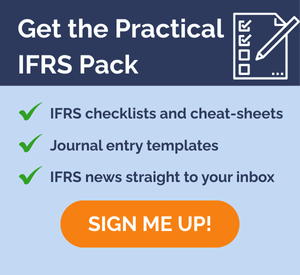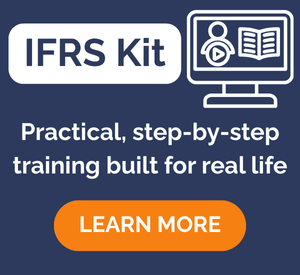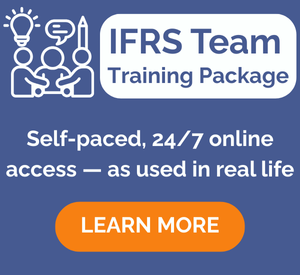A Practical Map of IFRS Standards: 7 Key Categories
There are over 40 IFRS standards, and without a structure, they can feel chaotic. But here’s the truth: every standard fits into one of a few big themes.
I call these themes IFRS Clouds, because each cloud groups related ideas.
There are 7 main categories (clouds) and please note that this is not any official guidance. It is just my own categorization to help you in your orientation.
Please note that when I write that some standard is core in the category, it does not mean that it is more significant than the other standards. It just means it is the hottest one and the most frequently used.
What you will find here (with links to free lectures):
- Category #1: Presentation and Disclosures in Financial Statements
- Category #2: Performance Reporting
- Category #3: Assets
- Category #4: Liabilities and Provisions
- Category #5: Financial Instruments
- Category #6: Group Reporting and Consolidation
- Category #7: Miscellaneous
- Conceptual Framework for Financial Reporting
- DOWNLOAD your IFRS map
- Free video lecture: IFRS Map
1. Presentation and Disclosures in Financial Statements
These standards define how financial statements are laid out, including the form, structure, and required components.
The major standard to focus on is IFRS 18 Presentation and Disclosure in Financial Statements, which guides the structure and content of financial statements.
The other standards in this category are:
- IAS 1 Presentation of Financial Statements (superseded by IFRS 18 from 2027)
- IAS 7 Statement of Cash Flows
- IAS 8 Basis of Preparation of Financial Statements (from 2027; older name: Accounting Policies, Changes in Estimates and Errors)
- IAS 10 Events after the Reporting Period
- IAS 24 Related Party Disclosures
- IAS 29 Financial Reporting in Hyperinflationary Economies
- IAS 33 Earnings per Share
- IFRS 8 Operating Segments
2. Performance Reporting
These standards drive what performance means and how it is measured and presented, focusing on revenues, expenses, and profits.
The essential one is IFRS 15 – Revenue from Contracts with Customers, which provides guidance on revenue, the lifeblood of every business.
The other standards in this category are:
- IAS 26 Accounting and Reporting by Retirement Benefit Plans
- IFRS 17 Insurance Contracts
3. Assets (Acquisition, Use, and Disposal)
This cloud governs how you handle assets throughout their lifecycle, from acquisition through use to disposal.
The core standard is IAS 16 Property, Plant and Equipment.
The other (equally important) standards in this category are:
- IAS 2 Inventories
- IAS 20 Accounting for Government Grants and Disclosure of Government Assistance
- IAS 23 Borrowing Costs
- IAS 36 Impairment of Assets
- IAS 38 Intangible Assets
- IAS 40 Investment Property
- IAS 41 Agriculture
- IFRS 5 Non-current Assets Held for Sale
- IFRS 6 Exploration for and Evaluation of Mineral Resources
4. Liabilities and Provisions
These standards cover obligations, debt, and uncertainty around liabilities. A key one is IFRS 16 Leases, but the others are also important:
- IAS 12 Income Taxes
- IAS 19 Employee Benefits
- IAS 37 Provisions, Contingent Liabilities and Contingent Assets
- IFRS 2 Share-based Payments
5. Financial Instruments
This group governs the complex area of financial instruments. The central standard is IFRS 9 Financial Instruments.
The other standards in this category are:
- IAS 32 Financial Instruments: Presentation
- IFRS 7 Financial Instruments: Disclosures
- IFRS 13 Fair Value Measurement (also applies to non-financial assets)
6. Group Reporting and Consolidation
These standards explain how to report groups of companies. The two most important are IFRS 3 Business Combinations and IFRS 10 Consolidated Financial Statements.
The other standards in this category are:
- IAS 27 Separate Financial Statements
- IAS 28 Investments in Associates and Joint Ventures
- IFRS 11 Joint Arrangements
- IFRS 12 Disclosure of Interests in Other Entities
- IFRS 19 Subsidiaries without Public Accountability
7. Miscellaneous
This cloud contains standards that apply to special circumstances or broadly across categories:
- IAS 21 The Effects of Changes in Foreign Exchange Rates
- IFRS 1 First-time Adoption of IFRS
- IFRS 14 Regulatory Deferral Accounts
Conceptual Framework
Finally, IFRS is supported by the Conceptual Framework for Financial Reporting.
This is not a standard itself, but it sets the basic principles and guidelines that underpin all other standards.
Return to top
DOWNLOAD your IFRS map
Here’s our IFRS map in a bird’s-eye view:

Return to top
Free video lecture: IFRS map
You can watch the video lecture explaining the IFRS Map here:
JOIN OUR FREE NEWSLETTER AND GET
report "Top 7 IFRS Mistakes" + free IFRS mini-course
Please check your inbox to confirm your subscription.
3 Comments
Leave a Reply Cancel reply
Recent Comments
- BSA on Change in the reporting period and comparatives
- J on Change in the reporting period and comparatives
- ali hag on A Practical Map of IFRS Standards: 7 Key Categories
- Salim Khader on IFRS 15 Explained: Full Guide on 5-step Model for Revenue Recognition + Free Journal Entries Template
- Silvia on Summary of IFRS 5 Non-current Assets Held for Sale and Discontinued Operations
Categories
- Accounting Policies and Estimates (14)
- Consolidation and Groups (25)
- Current Assets (21)
- Financial Instruments (56)
- Financial Statements (54)
- Foreign Currency (9)
- IFRS Videos (74)
- Insurance (3)
- Most popular (7)
- Non-current Assets (56)
- Other Topics (15)
- Provisions and Other Liabilities (46)
- Revenue Recognition (27)
- Uncategorized (1)




clear helpful ,,,, makes ifrs easier
Amazing expert
This is lovely.